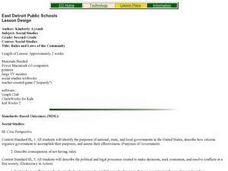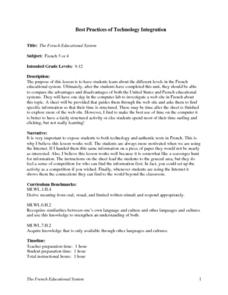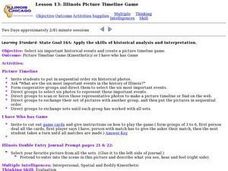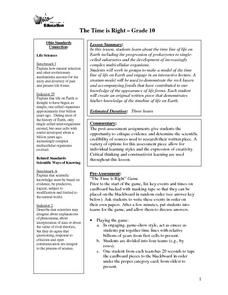Curated OER
Matter
Third graders are introduced to the topic of matter. As a class, they brainstorm what they already know about matter and its properties. After completing a worksheet, they participate in an experiment in which they observe matter in...
Curated OER
What's The Plan?
High schoolers identify how the human activities in the state of Maryland have changed/ evolved over the last 50 years. They evaluate a land planning document and prepare a fictitious planning document for a given area of land.
Curated OER
What Temperature Is It?
Students use the internet to research information on the average maximum and minimum temperature for a city in their state. They create spreadsheets and enter data to analyze the information, focusing on averages, maximums, minimums and...
Curated OER
Coin Art 4-6
Students study the historical figures and symbols of U.S.
patriotism depicted on the penny, nickel, dime, and quarter coins and learn that artists designed the portraits and other images on the coins. They research Texas symbols and...
Curated OER
Rules and Laws of the Community
Second graders recognize and identify the need for rules in school. They also discuss the importance of safety rules at school, home, and in the community. They illustrate a rule which they have learned in class, and write letters to the...
Curated OER
Teaching Matter with The Wild Christmas Reindeer
Second graders learn the proper way to take measurements, explore the properties of objects and expand their vocabulary.
Curated OER
Lesson 3: Where Does Money Come From?
Students listen to story Hundred Penny Box by Sharon Bell Mathis, explore history of money, and examine how money is produced in the United States. They discuss why money is used for exchange, and describe how money has changed over time.
Curated OER
The French Educational System
Students explore the different levels in the French educational system. They compare the advantages and disadvantages of both the United States and French educational systems.
Curated OER
Facing the Day
Students utilize magazines to find pictures that display emotional states/moods. Each student creates symbol cards using magazine pictures to help indicate how they are feeling on a given day. Individuals are instructed by the teacher...
Curated OER
You Scratch my Back, I'll Scratch Yours
Students explore the concept of interdependence. In this integrated interdependence lesson, students interpret graphs and charts that require them to analyze the relationship between Mexico and the United States. Students also...
Curated OER
Water Web-- Weather: Something We Talk a Lot About But Can't Change
In this science learning exercise, students study weather prediction by reading and completing activities in this 8 page newsletter. Students classify clouds, study weather prediction instruments, learn weather proverbs and signs and...
Curated OER
Shape Detectives
Students become "shape detectives" as they identify, name, create and describe common shapes within pictures and objects found within the learning environment. Suggestions include incorporating shapes into all learning areas and daily...
Curated OER
Clouds and Your Weather
Seventh graders identify clouds and the weather associated with them. They use informational articles and personal weather observations to learn about the relationships between weather fronts and clouds.
Curated OER
Life in Colonial Times
Fifth graders examine significant ideas, beliefs and themes in US history. They identify causes and effects of historical events in the American Revolution. Evaluate critical issues and events. Analyze the views and lives of people of...
Curated OER
Glossary, Index, and Table of Contents
Fourth graders use two separate sources to learn about index, glossary, and table of contents usage. In this library lesson, 4th graders use two books, Learning About Weather with Graphic Organizers, and The World Almanac for Kids, to...
Curated OER
ILLINOIS PICTURE TIMELINE GAME
Fourth graders explore Illinois state history by finding six historical photos and then putting them in sequential order.
Curated OER
The Time is Right
Tenth graders study the timeline of life on Earth. They learn about the progression of prokaryotes to single celled eukaryotes and the development of increasingly complex multicellular organisms.
Curated OER
Folk Dance Explorations in the Choreographic Work of Modern Dance
Tenth graders participate in a lesson guided by an essential question: in what ways does choreographer, Mark Morris' work, "The Office," reflect Eastern-European traditional folk dance? During the lesson's first sessions, students...
Curated OER
"COUNTRY" CHRISTMAS AND OTHER HOLIDAY CELEBRATIONS
Sixth graders develop an understanding of Christmas traditions of other countries and well as the United States. They discover the meaning of other holiday celebrations and utilize computers and other technology as an integral part of...
Curated OER
Internet: Writing Friendly Letters Via Email
Learners view a Powerpoint presentation on writing and sending email. After examining a Website about the parts of a friendly letter, they compose and send their own letters via email. Teachers set up an email/pen pal account so...
Curated OER
Navajo Code Talkers of WWII
Eighth graders assess different ways that significant individuals and events influenced economic, social and political systems in the United States after 1880. They experience a Navajo code talker's dictionary to create and decode messages.
Curated OER
Foundations of WWI
Students explore how World War I created a foundation for the United States to become a world power. In this World History lesson, students work in small groups to create posters and an oral presentation to share their findings with the...
Curated OER
Expanding Children's Geographic and Economic Worlds
Students learn their addresses and gain a sense of connection between their neighborhood and the rest of the world and the universe.
Curated OER
EMOTIONS AND GENDER EQUITY
Students discuss emotions and decide as a group which emotions are O.K. for males/females. They discuss solutions to gender bias in terms of the different emotions and write a reflective essay about what they learn from the discussion.




